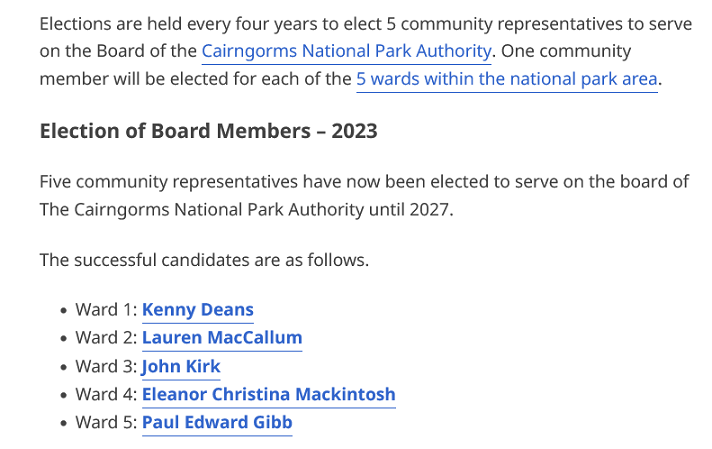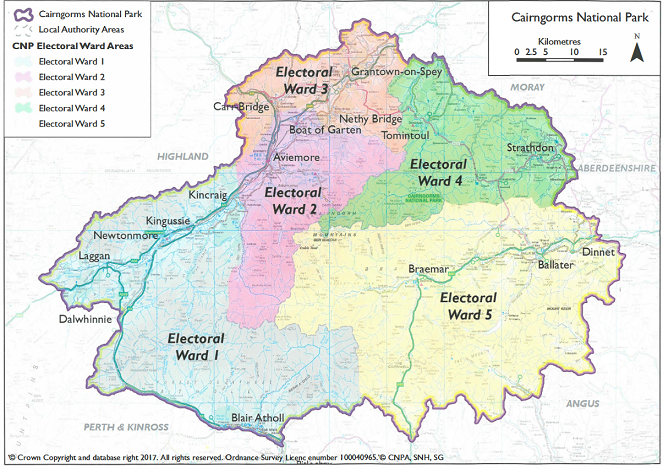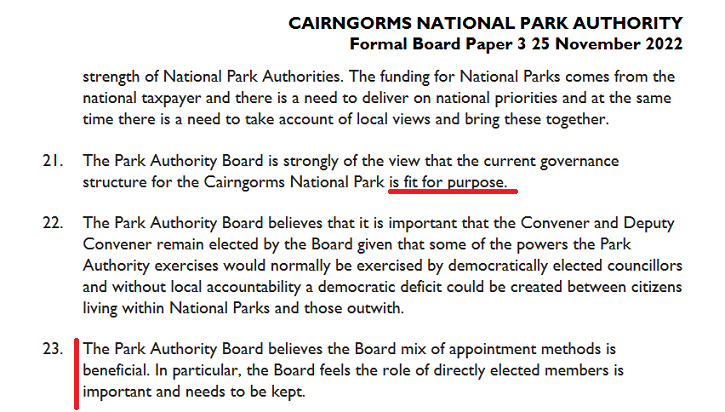 The results of the local member elections for the Cairngorms National Park Authority, which take place by post vote, were announced on Thursday 23rd March and confirm that the voting system in both our National Parks is in urgent need of reform (see here for the elections to the Loch Lomond and Trossachs National Park Authority (LLTNPA) last year).
The results of the local member elections for the Cairngorms National Park Authority, which take place by post vote, were announced on Thursday 23rd March and confirm that the voting system in both our National Parks is in urgent need of reform (see here for the elections to the Loch Lomond and Trossachs National Park Authority (LLTNPA) last year).
How the successful candidates were elected

Lauren MacCallum was elected unopposed in Ward 2. . I briefly met Lauren several years ago and while it is very good to see a younger person and a campaigner (she is linked to Protect Our Winters (see here)) on the National Park Board, it is extremely concerning that no-one else stood.
Does no-one else from Aviemore care what is going on in their local patch (HIE’s mismanagement of Cairn Gorm, the exclusion of the Aviemore and Glenmore Trust from bidding for the Glenmore campsite,the lack of public transport in Glenmore, BrewDog’s management of Kinrara etc etc)? One might have thought too with all the low paid and precarious jobs in the tourist industry around Aviemore that the opportunity to earn over £210 a day would be very attractive. But perhaps that is the point: our democracy is not in practice open to all and people in low paid precarious jobs may have risked losing them if they had stood for the Board.
Unlike for Council Elections, the voting system in our National Parks is still first past the post. Two of the candidates elected, John Kirk (876 out of 1688 votes) and Eleanor Mackintosh (252 out of 433) votes were elected by an absolute majority of those voting. However, the other two successful candidates were elected by a minority of those who voted. Kenny Deans, who won by 47 votes, received 37% of the vote (472 out of 1275) while Paul Gibb, who won by 52 votes, received just 28% of the votes cast (195 out of 694). Clearly, under a transferable voting system, different people might have been elected in these two wards.
Turnout in the four wards where there was an election was significantly higher than in the LLTNPA local member elections last year (36.5% compared to 31%), although there was significant local variation:
| Ward | 1 | 3 | 4 | 5 | (Total) |
| Votes cast | 1275 | 1688 | 433 | 694 | 4090 |
| Electorate | 3561 | 4274 | 1065 | 2305 | 11,205 |
| Turnout | 35.80% | 39.49% | 40.66% | 30.11% | 36.50% |
The higher turnout in the Cairngorms is perhaps a reflection of the effort that the current convener, Xander McDade, has invested in trying to get more people to participate and stand for election. Unfortunately, the first past the post system (6 people stood in ward 1 and 5 in Ward 5) and the very limited support available for candidates to express what they stand for (see here) means some candidates have a significant advantage over others.
The figures in the table illustrate a further issue. The size of the electoral wards vary enormously, with with electorate in Ward 3 four times the size of the electorate in Ward 4. That is not fair or proportionate.
Local member elections and the reform of Scotland’s National Parks
Local democracy is very important and one of the potential strengths of Scotland’s National Parks is the fact that a third of their Board Members are directly elected and not dependant on the patronage of Scottish Ministers. However, the way ward boundaries have been drawn and the first past the post voting system serves to undermine their democratic mandate. That mandate is further reduced where people are elected unopposed, like Lauren MacCallum, and the fact that only just over a third of the electorate vote: the percentage of the electorate which voted for the successful candidates in each ward ranged from 23% for Eleanor Mackintosh to just 8.4% for Paul Gibb. That is not good for democracy.
Both parliamentary and council ward boundaries are regularly revised to reflect changes in population but unfortunately Scotland’s National Parks fall outside the remit of the Electoral Commission and as a result there is no independent body responsible for ensuring the electoral system is fair or fit for purpose.
Parkswatch has tried to highlight the democratic deficit each time local member elections have taken place. Those deficits have been ignored by both of Scotland’s National Park Authorities. While the CNPA Board Meeting last November noted the forthcoming local member elections there appears to have been no discussion of the voting system. That Board Meeting also considered the CNPA’s submission to NatureScot’s review of National Parks but said nothing about the rotten voting system by which some of them had been elected:

While it is good to see the CNPA supports the local member system, how can they possibly defend the current electoral arrangements?
The response to NatureScot’s Review from the LLTNPA (see here) also failed to mention the rotten electoral system and instead chose to focus on “diversity”:
“5.24. In respect of the question of whether Governance arrangements should be reviewed the current approach does ensure that National Park Boards have a balance of local accountability and knowledge as well as national perspectives and experience in topics of relevance to National Park
management issues. However, an issue that should be considered for review is whether the current approach to Board appointments and elections is fit for purpose in securing more diversity on our Boards. Members will be aware that significant effort [that is debatable when turnout was 5% lower than in the Cairngorms] has gone in to encouraging as diverse a range of candidates as possible to put themselves forward to be Board members. The National Park Authority has provided promotional material and held drop–in events to encourage people from a wide range of backgrounds to consider standing in the direct elections. A similar approach is taken to encouraging applicants for Minister–appointed Board places. The outcome is that the current three processes that we have for electing and appointing Board members is not delivering the equality, diversity and inclusion outcomes that are being aspired to in Scottish public life.”
What is lacking here is any understanding that improved democracy might lead to greater diversity or that diversity of views is good for democracy (the LLTNPA has continually told locally elected members that their role is to do the bidding of Scottish Ministers rather than represent their electorate) .
NatureScot published their advice to Scottish Ministers about the reform of Scotland’s National Parks and how to create new ones in February (see here). It was strong on the role of local communities:
“3.18 All the responses to this question strongly affirmed that local communities have a very important role to play in success of National Parks. Most responses focused on ‘working with’ rather than ‘working for’ local communities with some also highlighting the central importance of local communities in realising a just transition.”
While referring to “the need to maintain local presentation (sic)” and to reform governance arrangements i (paras 4.33 and 4.34) it had nothing to say about reforming the voting system in our National Parks. This creates a major contradiction at the heart of NatureScot’s advice to the Scottish Government. Their advice suggests local communities should be central to choosing Scotland’s next National Park but contains no suggestion for how this might be done democratically: without democracy, the involvement of local communities in choosing National Parks is likely to be window dressing, just like the locally elected representatives are at present – a figleaf to cover up increasingly centralised control.
The message from our Non-departmental Public Boards”, all of which are controlled by central government, is that democracy doesn’t matter much. Luckily with legislation likely, the opportunity for reform by our MSPs is still there.
Democracy and transparency
As a final comment on the state of democracy in our National Parks, while Highland Council which was responsible for overseeing the elections live streamed the count and you can view that on their You Tube channel (see here), once National Park Board Meetings are over you cannot view what was discussed.
There is a reason for that which is nicely illustrated by the minutes of the November Board Meeting which were made in March (see here): it is worth taking two minutes to read item 2, Declarations of Interest. Clearly there was a significant battle between staff and certain Board Members and in my view it would be in the public interest that that was available for everyone to view. Whatever the rights and wrongs in this case, the point here is that for democracy to work, we also need transparency and our National Park Authorities at present are far from open or transparent. That also should be addressed in any new legislation on National Parks.
Too few positions are elected. Far too many posts are filled by appointment and some of those appointed are less than progressive in their views.
As for getting folk to vote it’s an old issue, council elections have the same problem. Unless voting is made compulsory (as in some other countries) there’s no easy solution. Our community councils suffer from a lack of folk too. Although the solution there may be to give CCs more power.
CCs should certainly not have any more power UNLESS they are made very much more democratic and accountable FIRST.
This should include: Requirement for members to be elected by their community with a defined percentage of that electorate. Co – options to be severely limited in number and duration. Members to be elected from defined sections of the community e.g. a certain number of local business owners, professionals etc. as well as ordinary members.
Too many current CCs are comprised mainly or solely of retired NIMBYs and their only saving grace is they have no actual power. All they do is object to each and every planning application, usually on spurious grounds which are ignored.
The mechanisms exist for individuals to communicate with and make representations to their local authorities and wider governments, it is not necessary to have a self appointed group who do not represent local views operating in parallel.